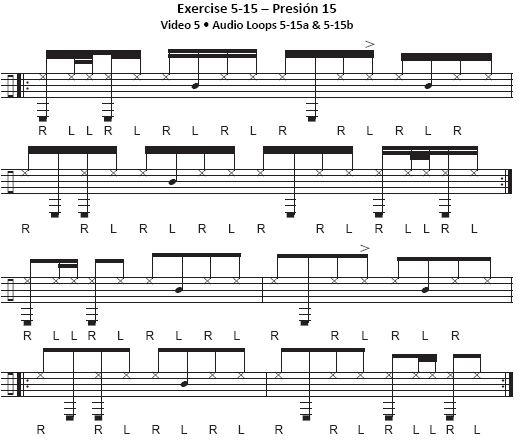Indice - Table of contents
Lo Nuevo[hide]
Reportes: From The St... : Cubadisco 2...
Fotos: Tom Ehrlich
Staff: Kristina Lim
Musicos: Juan Formell
Musicos: Yordamis Megret Planes
Musicos: Yasser Morejón Pino
Musicos: José Luis "Changuito" Quintana...
Musicos: Dennis Nicles Cobas
Fotos: Eli Silva
Grupos: Ritmo Oriental : 1988 - Vol. IX - 30 a...
Musicos: Rafael Paseiro Monzón
Musicos: Jiovanni Cofiño Sánchez
Fotos: Tom Ehrlich : 2024 Monterey Jazz, P...
Resenas: Vacilón Santiaguero (Circle 9 ...
Fotos Del Día [hide]
Questions & Answers - Answers 2
In the books, how is the drum music notated?

Okay, let's take it from the top:
1) the title:
Exercise 5‐15 – Presión 15
Video 5 • Audio Loops 5‐15a & 5‐15b
So, 5-15 means Chapter 5-Exercise 15, the title of which is Presión 15 (presión being the timba gear where the bass and congas drop out and the singer cries "manos pa'arriba" and everyone goes crazy. Then, in the second line, Video 5 means it's taken from Video 5 of the video product and then the corresponding audio product loops are listed: fast ("15a") and slow ("15b").
2) the top two staves - this is the 2-clave loop written in 16th notes.
3) the bottom two staves - this is the same loop written in 8th notes.
4) the letters - when it's not obvious, I use L and R to show which hand Calixto uses.
5) the notation itself - Each book has a long chapter which lovingly explains every detail of the notation system, along with a nice little history of each instrument. It's all very carefully thought out so that, for example, triangles are always bells, solid notes are tones, hollow notes are muted, and so on. The free downloadable PDF has two big drum keys that show all this. They're arranged so that they have blank pages on the back, so you can take them to the copy shop and have them print them on a professional printer, then put them back to back and laminated them so you'll have a permanent, sturdy drum key to use while studying the music. There's also a third key that explains the terminology in X & o notation. All the different claves, cáscara, campaneo, master kick drum patterns and so on.
If these are Beyond Salsa Percussion Volumes 2 and 3, what about Volume 1?
Volume 1 is a placeholder for a book I haven't written. It will be an overview and history of the entire rhythm section, written for complete beginners. It will have the most basic patterns for every instrument: bass, piano, drums, timbales, congas, bongó, güiro, kick drum, clave and so on. There will be videos of various players. The idea is that someone who doesn't play the instruments would be able to play the simplest rhythm patterns for each one - good for listerners, dancers, players of other instruments, and arrangers.
What's the difference between Volumes 2 and 3?
The format of the two volumes is similar. Each has six long chapters of notated exercises and text explanation. Volume 2 covers traditional rhythms that Calixto had mastered before he started playing timba with NG La Banda, Adalberto and Pachito. He shows the original rhythms and then shows all the ways he can modernize them, incorporate them into timba and so on. The six chapters are:
1. Danzón - incuding an extensive history, analysis and listening recommendations. Instead of just the standard baqueteo pattern, he shows how baqueteo, paseo and the danzón bell fit together in the long sophisticated arrangements of authentic danzón.
2. Chachachá - also covers the history.
3. Mozambique - starts with the basic rhythm of the 60s and then applies it to the full drumset in various ways, some of the quite conducive to timba.
4. Pilón - Calixto spent years with this famous rhythm's creator, Pacho Alonso, and later his son Pachito, so he's spent a lot of time with pilón, and also Simalé and Upa Upa. Again, he starts basic and then adapts it to the drums in many different ways.
5. Simalé - another classic Pacho Alonso/Enrique Bonne rhythm - heavy on the jam block.
6. Upa Upa - still another from Pacho, this one focuses on the snare and is clearly one of the influences for Calixto's trademark Échalé limón snare ride.
click NEXT to the lower right for a similar description of Volume 3.

















